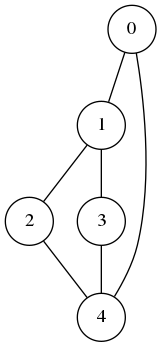Eccentricity, Radius and Diameter in a Graph, Revisited
A previous post on this blog on radius and diameter of a graph gets a lot of traffic consistently. I have been looking at the code and one can refactor it to make it more efficient.
Edge-list Representation vs Topological Representation
In almost all of my posts on graphs on this blog, I have been usingthe set of edges as a representation for a graph. Today, I am going to represent graphs topologically, that is, by listing the neighboring vertices of a given vertex. For example, the graph whose edge list representation is
(defvar G '((0 1) (1 2) (1 3) (2 4) (3 4) (0 4)))
G
can also be represented by
((0 1 4) (1 0 2 3) (2 1 4) (3 1 4) (4 0 2 3))where each sublist is a cons pair where the
car is the vertex and cdr is the list of
vertices adjacent to that vertex.
I am going to need a function that makes the conversion:
(defun convert (G)
(let ((H (remove-duplicates
(union G (mapcar #'reverse G))
:test #'equal))
(res nil))
(dolist (edge H res)
(if (assoc (car edge) res)
(push (cadr edge) (cdr (assoc (car edge) res)))
(push (copy-list edge) res)))))
CONVERT
(defvar H (convert G))
((4 0 3 2) (1 0 2 3) (2 1 4) (3 1 4) (0 1 4))Since lists are ordered and I want an undirected graph, you see in the code that I take the union of edges and reverse edges.
Now, a utility function that returns the list of vertices of a given graph.
(defun vertices (G)
(remove-duplicates (reduce #'append G)))
VERTICESThe beauty of this function lies in the fact that it returns the correct set for both representations:
(vertices G)
(1 2 3 0 4)
(vertices H)
(2 3 0 1 4)And now the eccentricity function:
(defun eccentricity (x G)
(let* ((A (vertices G))
(size (length A)))
(labels ((vicinity (u) (assoc u G)))
(do ((n 0 (1+ n))
(V A (set-difference V W))
(W (vicinity x)
(intersection V (reduce #'append (mapcar #'vicinity W)))))
((or (null V) (> n size)) n)))))
ECCENTRICITYThis function comes with a warning: the return value is not correct for disconnected graphs. The eccentricity of a graph can not be greater than the number of edges. So, if you see this function returning number of vertices plus 1, understand that the graph was disconnected.
(eccentricity 0 H)
2Once we have that, the radius and the diameter function is defined the same way:
(defun radius-and-diameter (G)
(let* ((H (convert G))
(base (mapcar (lambda (x) (eccentricity x H)) (vertices H))))
(list (apply #'min base) (apply #'max base))))
RADIUS-AND-DIAMETERand we get
(radius-and-diameter G)
(2 2)And if you recall, the distance function is very similar to the eccentricity function:
(defun dist (x y G)
(let* ((A (vertices G))
(size (length A)))
(labels ((vicinity (u) (assoc u G)))
(do ((n 1 (1+ n))
(V A (set-difference V W))
(W (vicinity x)
(intersection V (reduce #'append (mapcar #'vicinity W)))))
((or (member y W) (> n size)) n)))))
DISTand we get
(loop for i from 0 below 4 append
(loop for j from (1+ i) to 4 collect
(list i j (dist i j H))))
((0 1 1) (0 2 2) (0 3 2) (0 4 1) (1 2 1) (1 3 1) (1 4 2) (2 3 2) (2 4 1)
(3 4 1))